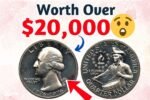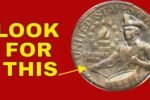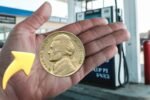Rare: Stories of rare coins fetching fortunes often fuel the dreams of collectors and casual coin handlers alike. But recently, a new headline has stirred an internet frenzy: a Lincoln Wheat Penny allegedly worth \$880 million. Such a staggering valuation has captured imaginations across the world but does this claim hold any truth ? Could such a coin truly exist, and if so, is it still in circulation today, waiting to be found?
The Real History Behind the Lincoln Wheat Penny
First minted in 1909 to honor Abraham Lincoln’s centennial birth anniversary, the Lincoln Wheat Penny became the first U.S. coin to feature a real person rather than a symbolic figure. Designed by Victor David Brenner, the coin shows Lincoln’s profile on the obverse and two wheat stalks on the reverse symbols of America’s agricultural roots.
This iconic coin remained in production until 1958, replaced later by the Lincoln Memorial design. While billions were circulated, only a few variants are truly rare and valuable today.
What Is the Most Expensive Penny Ever Sold ?
Despite the buzz, no Lincoln Wheat Penny has ever sold for \$880 million. In reality, the highest price ever paid for a Lincoln cent was \$1.7 million a 1943 bronze penny, sold in 2010. This rare coin was a wartime minting error, made when the U.S. Mint switched to steel pennies to conserve copper. A few 1942 copper planchets accidentally remained in the minting machines, producing a tiny number of 1943 copper cents now among the most coveted American coins.
Even the most expensive coin ever sold in history a 1933 Double Eagle gold coin—only reached \$18.9 million in 2021. So the claim of a penny being worth \$880 million is, quite simply, not grounded in reality.
Why the \$880 Million Claim Is Misleading
The origin of this inflated figure likely lies in internet exaggeration, clickbait headlines, or simple typographical errors. A likely possibility is a misrepresentation of “\$880,000” as \$880 million a mistake that spiraled into viral misinformation.
Online platforms often prioritize engagement over accuracy, allowing such stories to spread unchecked. And while the idea of an ultra-rare coin secretly sitting in someone’s change jar is exciting, the economics of the collectibles market do not support valuations even remotely close to \$880 million.
Genuine Valuable Pennies You Can Actually Find
Even though the \$880 million penny is fiction, several Lincoln Wheat Pennies are truly valuable, and still turn up in collections and coin rolls:
- 1943 Bronze Penny – Worth up to \$1.7 million
- 1944 Steel Penny – A reverse error worth over \$100,000
- 1909-S VDB Penny – Features designer’s initials and can be worth \$50,000–\$100,000
- 1914-D Penny – A low mintage coin valued up to \$15,000
- 1922 No D Penny – Minting error without a mint mark, valued at \$20,000+
- 1955 Doubled Die Penny – With noticeable doubling of letters, sells for \$1,000–\$50,000+
These figures are substantial but believable, firmly rooted in actual sales data and verified by professional numismatists.
How to Spot a Valuable Lincoln Wheat Penny
If you’re checking your change for hidden treasure, look for these traits:
- Dates to note: 1909-S VDB, 1914-D, 1922 (No D), 1931-S, 1943 (bronze), 1944 (steel), 1955 doubled die
- Mint Marks: Found below the date on the obverse—“D” for Denver, “S” for San Francisco, or none for Philadelphia
- Condition: The clearer the details on Lincoln’s face and the wheat stalks, the higher the potential value
- Magnet Test: 1943 bronze cents won’t stick to magnets, while steel ones will
- Weight Test: A copper penny weighs around 3.11 grams, while a steel penny is lighter at 2.7 grams
If in doubt, always consult with a certified coin dealer or grading service like PCGS or NGC.
Misinformation and the Role of Social Media
The \$880 million penny hoax is a prime example of how false information can go viral. Sensational claims, especially those related to easy money, are easily shared online. Once one article or video gains traction, dozens more copy and amplify the claim often without verification.
This phenomenon can give false hope to readers, while distracting them from the real opportunities and historical richness of coin collecting. Misinformation also undermines trust in the numismatic community, which values accuracy, authentication, and education.
The Real Joy of Coin Collecting
While you likely won’t find a coin worth hundreds of millions, you can absolutely find coins worth thousands. And more importantly, coin collecting offers:
- A historical journey through American life and culture
- An affordable, accessible hobby
- A chance to connect with fellow collectors
- The thrill of discovery, especially in something as ordinary as pocket change
Many collectors got started after hearing about valuable finds in circulation some even inherited boxes of old coins that turned out to be worth more than expected.
A Penny’s Historical Significance Beyond Price
The Lincoln Wheat Penny was more than just currency. It was a symbol of America’s shift in coin design, celebrating Abraham Lincoln instead of mythic figures like Liberty. These coins were exchanged during the Great Depression, World Wars, and the rise of modern America.
Each one tells a story about the people who used it, the era it came from, and the history it represents. That’s something no dollar value, not even \$880 million, can fully capture.
Truth Over Hype
While the claim of a \$880 million Lincoln Wheat Penny is completely false, the broader message holds true: valuable coins do exist, and some may still be out there. With patience, knowledge, and a sharp eye, it’s possible to discover hidden gems.
So the next time you receive change, pause and look closely. Even if you don’t strike it rich, you’ll gain a deeper appreciation for American history and perhaps ignite a lifelong passion for collecting.




